Forest Markets - A Key Component of Successful Habitat Management
The Tri-state Conservation Partnership (TCP) continues to work in support of habitat management and Desired Forest Conditions for Wildlife (DFCW) through collaboration and coordination with the forest products industry and wood suppliers in the MAV.
Since its establishment, the TCP has placed the management of bottomland hardwood plantations on Wetland Reserve Easements (WRE) high on its list of priorities and objectives. The partnership has developed several important tools designed to assist landowners and technical professionals with making and implementing forest management decisions on easements, including a Landowner Guide, a Tool for Assessment and Treatment of Reforested Bottomland Hardwood Stands on WRE, and a web-based WRE Plantation Age Estimator Tool. In addition, the TCP has worked over the past two years to develop a seven-video series targeted at management of WREs. The series includes two videos focused specifically on management of easement forests (series to be release before the end of 2021).
In addition to developing these targeted outreach tools, the TCP has been working to support and advance awareness of MAV forest markets over the past several years. Specifically, the partnership has begun building stronger working relationships with key players in the MAV forest products industry and its wood suppliers. This has included various partner meetings with MAV industry leaders such as International Paper (IP) and DRAX, as well as site visits with wood product suppliers. These TCP-grounded efforts have proven highly beneficial to advancing shared understanding between conservation community interests and forest industry needs, demands, and priorities.
Developing markets for hardwood fiber from WRE sites
AR MAV CDN Field Trip - Dagmar WMA
One recent example of these relationship-building efforts includes the 2021 award of a National Fish & Wildlife Foundation grant to the Louisiana Wildlife and Fisheries Foundation and its partners. Grant objectives will be achieved through project partners joining with local wood suppliers and corporate forest industry partners to address barriers to treatment of hardwood plantations. The project will facilitate the development of markets for hardwood fiber from treated sites. Another great example of this effort was an August site visit to an active bottomland hardwood plantation thinning operation on Malmaison WMA in the Mississippi delta. The site visit and great field discussion among TCP partners, IP staff, and the wood supplier were the result of an invitation from IP to the TCP. Other recent examples include presentations by IP’s Global Fiber Projects Manager, Jeremy Poirier, at summer membership meetings of both the LA/MS MAV and AR MAV CDNs. Poirier shared valuable information and insight with attendees, including the state of MAV hardwood pulp markets, current IP mill product priorities, evolving forest certification and sustainability demands, and specifics on the ever-increasing expectations from its worldwide customer base. These MAV CDN meetings placed specific focus on DFCW, with presentations at each meeting from experienced wildlife foresters on DFCW implementation. The AR MAV CDN meeting also included a field trip to Dagmar WMA to view and discuss various DFCW-based treatments.
Unfortunately, during most of this period of focused collaboration and relationship building, MAV markets for hardwood pulp products have significantly declined. The declines are due to a variety of factors, including closings of multiple regional mills and changes in products produced by some mills. The resulting decline in forest product demand has reduced the number of loggers and log haulers, a situation that has been further exacerbated by Covid 19 coupled with the growing impact of extended periodic flooding in the MAV.
Even with these challenges, the benefits of the TCP’s work to strengthen its relationship with the forest products industry in the MAV have recently proven particularly fruitful. All of the variables that have conspired to reduce hardwood pulpwood demand in the MAV have now brought about a hardwood pulp shortage at some mills and wood yards. In recent weeks, IP has again reached out to the TCP to make partners aware of significantly increased hardwood pulp demand, which also means improved stumpage prices. The TCP has responded to the call through proactive partner coordination, working directly with WRE landowners who have approved Compatible Use Authorizations, and—with landowner approval—sharing that information with key industry leads.
Though it is not certain at this point whether these recent developments will result in habitat improvements through WRE plantation treatments, what is evident are the innate benefits that flow from ongoing, proactive, and collaborative partnership. Though we cannot always see what lies ahead, we will always be stronger and more successful together!


